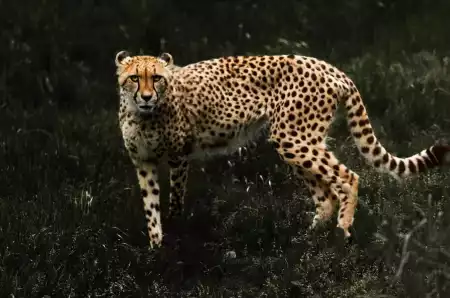 Photo of a Cheetah by Trace Hudson
Photo of a Cheetah by Trace Hudson
Felines Quiz
How much do you know about Felines?
Are you a cat enthusiast or intrigued by the majestic big cats of the wild? Dive into our Felines Quiz and test your knowledge about these elegant and mysterious creatures.
From the regal lions of the savannah to the nimble domestic cats in our homes, felines captivate us with their grace, agility, and enigmatic personalities.
Whether you're a fan of the powerful tiger or the charming house cat, this quiz has something for everyone. Let's see how much you know about these extraordinary members of the animal kingdom. Get ready to explore the diverse and fascinating world of felines!
Start the Felines quiz
Questions and answers about Felines
-
What is the largest feline in the world?
The Siberian Tiger is the largest feline in the world. Males can weigh up to 660 pounds (300 kg) and measure up to 12 feet (3.7 meters) in length, including their tail.
- Siberian Tiger
- African Lion
- Jaguar
- Cheetah
-
Which feline is known for being the fastest runner?
The Cheetah is known for being the fastest runner among felines, capable of reaching speeds up to 70 miles per hour (113 km/h) in short bursts covering distances up to 1,500 feet.
- Cheetah
- Leopard
- Puma
- Ocelot
-
What is the most common wild cat in the Americas?
The Bobcat is the most common wild cat in the Americas. Known for its adaptability, it inhabits wooded areas, as well as semi-desert, urban edge, and swampland environments.
- Bobcat
- Canadian Lynx
- Ocelot
- Puma
-
Which small to medium-sized wild feline is capable of descending headfirst down trees, like squirrels?
The Margay is renowned for its exceptional ability to climb down trees headfirst, a skill shared only with the clouded leopard. This capability is attributed to its extremely flexible ankle joints, which can rotate up to 180 degrees.
- Margay
- Bobcat
- Red Lynx
- Caracal
-
Where is the Catopuma badia native?
The Catopuma badia, also known as the Borneo Bay Cat, is an elusive and rare species native to the island of Borneo. This feline is one of the world's least known and most endangered wild cats.
- Borneo
- Sumatra
- Java
- Bali
-
What is the name of the smallest wild feline in the world?
The Rusty-Spotted Cat, Prionailurus rubiginosus, is the smallest wild feline in the world. Found primarily in India and Sri Lanka, this tiny cat weighs only 2-3.5 pounds (0.9-1.6 kg).
- Rusty-Spotted Cat
- Black-Footed Cat
- Sand Cat
- Kodkod
-
What is the typical lifespan of a domestic cat?
The typical lifespan of a domestic cat is around 12 to 15 years. However, with proper care, some cats can live into their twenties and occasionally beyond.
- 12 to 15 years
- 5 to 8 years
- 18 to 20 years
- 10 to 12 years
-
Which wild cat species is known for having no tail?
The Manx cat, a breed originating from the Isle of Man, is known for having no tail. This unique trait is the result of a genetic mutation.
- Manx cat
- American Bobtail
- Japanese Bobtail
- Cymric cat
-
What wild cat is known for its ability to survive in desert environments?
The Sand Cat is known for its remarkable ability to survive in desert environments. It can live without water, getting moisture from its prey, and withstand extreme temperatures.
- Sand Cat
- African Wildcat
- Fennec Fox
- Caracal
-
What is the most endangered feline species according to the IUCN?
The Amur Leopard is considered the most endangered feline species according to the IUCN, with fewer than 100 individuals left in the wild due to habitat loss and poaching.
- Amur Leopard
- Sumatran Tiger
- Javan Leopard
- Snow Leopard
-
How fast can a cheetah run?
The cheetah is the fastest land animal, capable of reaching speeds up to 75 miles per hour (120 kilometers per hour) in short bursts, primarily to catch prey.
- 75 miles per hour (120 km/h)
- 55 miles per hour (88 km/h)
- 65 miles per hour (105 km/h)
- 85 miles per hour (137 km/h)
-
How far can a lion's roar be heard?
A lion's roar is one of the most powerful among big cats, audible up to 5 miles (about 8 kilometers) away. It's used for communication and territorial dominance.
- 5 miles (8 km)
- 2 miles (3.2 km)
- 3 miles (4.8 km)
- 4 miles (6.4 km)
-
How high can a caracal jump to catch its prey?
The caracal is known for its remarkable ability to leap up to 10 feet (3 meters) into the air, a skill it uses to catch birds and other flying prey.
- 10 feet (3 meters)
- 6 feet (1.8 meters)
- 8 feet (2.4 meters)
- 12 feet (3.7 meters)
-
What adaptation helps the Siberian tiger survive in cold climates?
The Siberian tiger has a thick fur coat and a layer of fat, adaptations crucial for surviving the harsh Siberian winter. Its large paws act like snowshoes on snow.
- Thick fur and fat layer
- Short fur for camouflage
- Webbed feet
- Small ears to retain heat
-
How many subspecies of cheetah are there?
There are five recognized subspecies of the cheetah (Acinonyx jubatus): the South African cheetah (A. j. jubatus), the East African cheetah (A. j. raineyi), the Northeast African cheetah (A. j. soemmeringii), the Northwest African cheetah (A. j. hecki), and the Asiatic cheetah (A. j. venaticus).
- Five
- Three
- Four
- Six
-
How many teeth does an adult tiger have?
An adult tiger has 30 teeth, designed for gripping, cutting, and tearing meat. The canines, which can be up to 4 inches (10 cm) long, are crucial for capturing and killing prey.
- 30
- 42
- 36
- 28
-
Where does the jaguar primarily live?
The jaguar primarily lives in the Americas, ranging from the southwestern United States and Mexico through Central to South America. It prefers dense forests and wetlands.
- Americas
- Africa
- Asia
- Europe
 Leopard on Brown Trunk Tree. Pixabay
Leopard on Brown Trunk Tree. Pixabay
About Felines
Felines, commonly known as cats, are a diverse group of mammals that belong to the family Felidae. This family includes both domesticated cats and wild cats. Here are some key aspects about felines:
Diversity: The Felidae family comprises various species, including well-known big cats like lions, tigers, leopards, and cheetahs, as well as smaller species like domestic cats, lynxes, and ocelots.
Physical Characteristics: Felines are known for their agile bodies, sharp retractable claws, and keen senses, particularly their excellent night vision and sensitive whiskers, which are crucial for hunting and navigating in the dark.
Hunting and Diet: Most felines are carnivorous predators, adept at stalking and capturing prey with a combination of stealth, speed, and power. Their diet mainly consists of meat, and they play a crucial role in maintaining the balance of ecosystems by controlling the population of their prey.
Communication: Felines communicate through various means, including vocalizations (like roars, purrs, hisses), visual cues (like ear and tail movements), and scent marking.
Domestication: The domestic cat (Felis catus) is one of the most popular pets worldwide. Domestic cats have been valued companions for thousands of years, dating back to ancient Egyptian times.
Conservation: Many wild feline species are facing threats due to habitat loss, poaching, and conflicts with humans. Efforts are being made globally for their conservation, focusing on habitat preservation and mitigating human-wildlife conflicts.
Behavioral Traits: Felines are known for their solitary nature, especially in wild species. However, some, like lions, exhibit social behaviors and live in groups.
Understanding felines is crucial not only for their conservation but also for appreciating the role they play in various ecosystems and cultures across the world.
Do you love animals? We have plenty of animal quizzes to satisfy your curiosity and test your knowledge. Check them out!